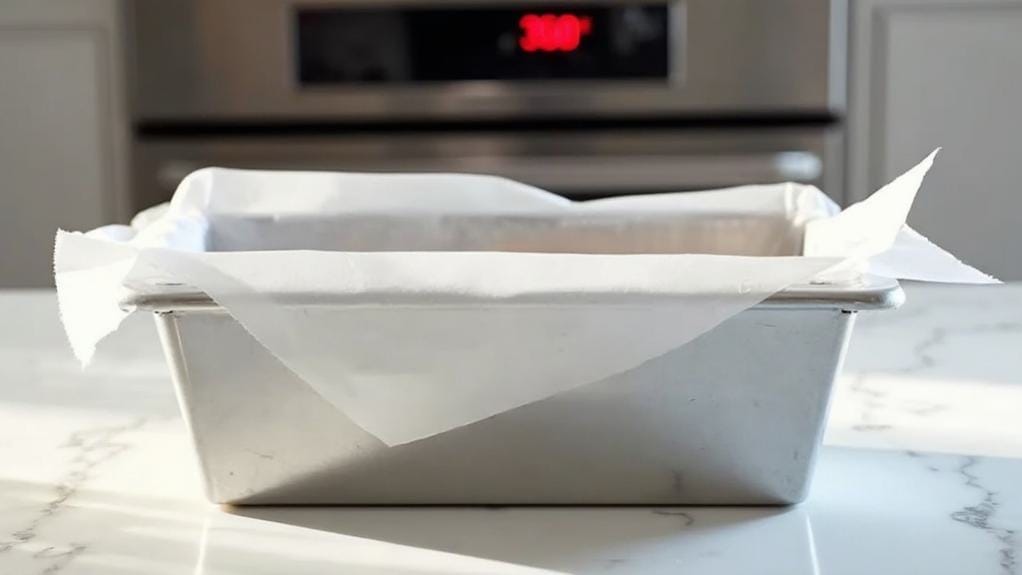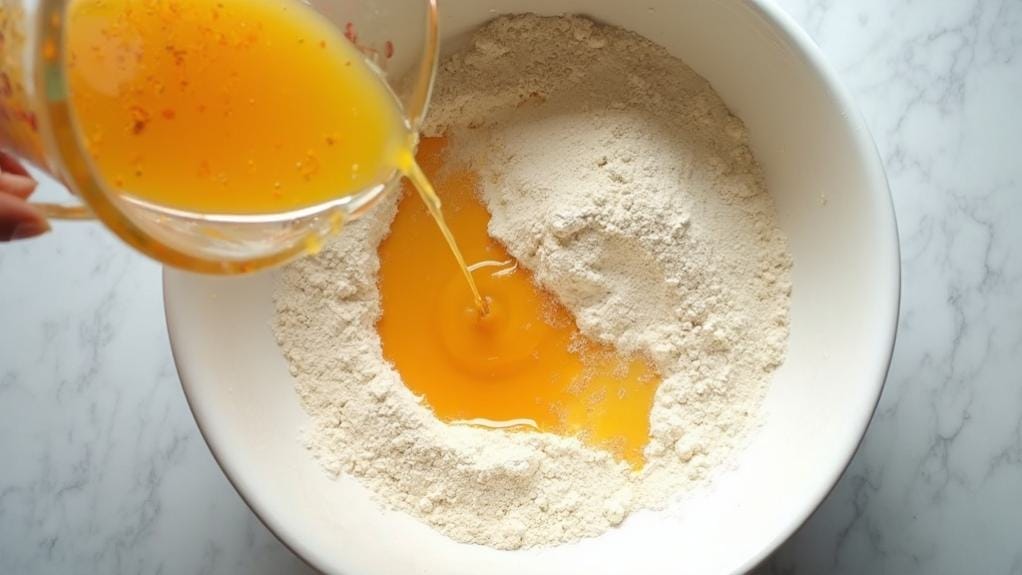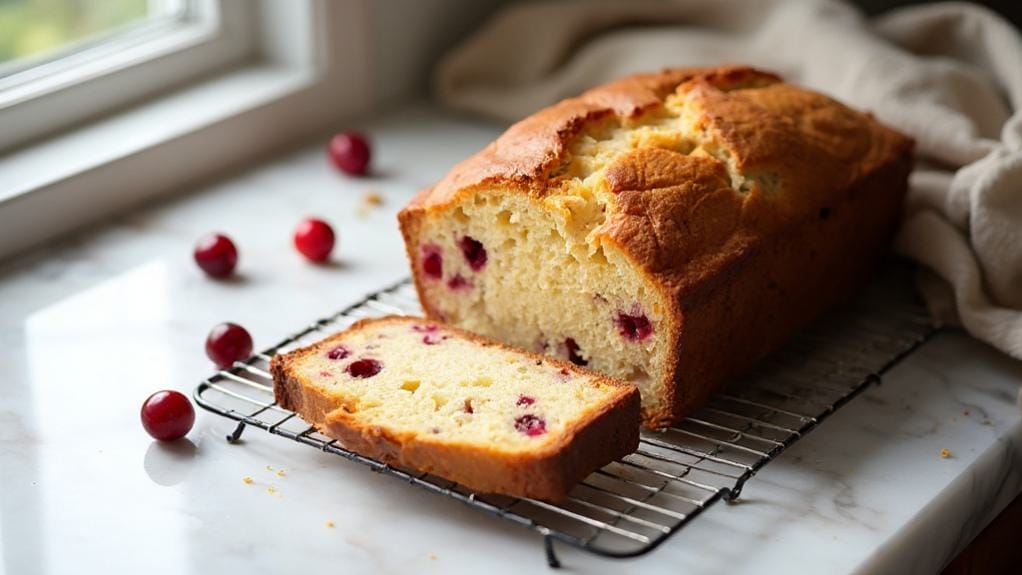As I arrange fresh cranberries and citrus on my marble countertop, I’m reminded of the first time I discovered the harmonious pairing of tart berries and bright orange zest in this classic bread. There’s something inherently sophisticated about this combination – the way the crimson berries burst during baking, creating pockets of intense flavor, while the orange essence weaves through each tender slice.
While many consider this a seasonal offering, I’ve found that mastering the nuances of this recipe transforms it into a year-round treasure, and I’m prepared to share my carefully refined techniques.
Recipe
Cranberry Orange Bread is a delightful vegan treat that combines the tartness of fresh cranberries with bright citrus notes. This classic quick bread has been thoughtfully adapted to create a completely plant-based version that maintains all the moisture and flavor of the traditional recipe.
The secret to this bread’s success lies in its carefully balanced ingredients, where flaxseed acts as a binding agent, and the combination of plant milk and apple cider vinegar creates a vegan buttermilk substitute. The result is a tender, flavorful loaf studded with bursts of cranberry and infused with fresh orange essence.
- 2 cups all-purpose flour
- 1 cup granulated sugar
- 1½ teaspoons baking powder
- ½ teaspoon baking soda
- ½ teaspoon salt
- 2 tablespoons ground flaxseed
- 6 tablespoons water
- 1 cup plant-based milk
- 1 tablespoon apple cider vinegar
- ⅓ cup vegetable oil
- 2 oranges, zested
- ¼ cup orange juice
- 1½ cups fresh cranberries
- ½ cup chopped walnuts (optional)
Preheat oven to 350°F and line a 9×5-inch loaf pan with parchment paper. Begin by combining ground flaxseed with water in a small bowl and let stand for 5 minutes until thickened.
In a large bowl, whisk together flour, sugar, baking powder, baking soda, and salt. In a separate bowl, mix plant-based milk, apple cider vinegar, oil, orange zest, orange juice, and the flaxseed mixture.
Pour the wet ingredients into the dry ingredients and stir until just combined. Fold in cranberries and optional walnuts. Transfer batter to the prepared pan and bake for 55-60 minutes, or until a toothpick inserted into the center comes out clean.
For optimal results, bring all ingredients to room temperature before starting. Chop the cranberries in half to prevent them from sinking to the bottom of the loaf. The bread needs to cool completely before slicing to prevent crumbling.
Store the bread wrapped tightly in plastic wrap at room temperature for up to 3 days, or freeze for up to 3 months. Always zest the oranges before juicing them for maximum flavor extraction.
Step-By-Step Cooking Instructions
You’ll begin by preheating your oven to 350°F and preparing your loaf pan with parchment paper while mixing the wet ingredients, including flax eggs, plant milk, vinegar, oil, and orange components.
Next, you’ll whisk together your dry ingredients in a separate bowl before carefully incorporating the wet mixture into the dry until just combined, being mindful not to overmix.
Finally, you’ll transfer your batter to the prepared pan and bake for 55-60 minutes, allowing the loaf to cool completely before slicing.
Step 1. Preheat and Prepare Pan

Begin your baking journey by preheating your oven to 350°F (175°C) and preparing a 9×5-inch loaf pan with parchment paper.
You’ll want to ensure your oven reaches the proper temperature before proceeding, as this will guarantee even baking and optimal rise for your cranberry orange bread.
Cut a piece of parchment paper large enough to cover the bottom of your pan with extra length extending up the long sides, creating handles that will help you lift the finished bread out easily.
Smooth the paper into the corners, pressing firmly to eliminate any air pockets. If you’re concerned about sticking, you can lightly grease the exposed short ends of the pan with vegetable oil.
While your oven preheats, gather all your ingredients and bring them to room temperature.
This crucial step ensures proper incorporation of wet and dry ingredients later in the process.
You’ll also want to position your oven rack in the center position, allowing for consistent heat distribution throughout the baking process.
Step 2. Mix Wet Ingredients Together

With your oven preheating and pan prepared, it’s time to focus on combining your wet ingredients. In a medium mixing bowl, start by making your flax egg – combine 2 tablespoons of ground flaxseed with 6 tablespoons of water, then let the mixture rest for 5 minutes until it develops a gel-like consistency.
While the flax mixture thickens, pour 1 cup of room-temperature plant-based milk into a separate bowl and add 1 tablespoon of apple cider vinegar. Let this mixture stand for a moment – it’ll create a plant-based buttermilk substitute.
Next, add ⅓ cup of vegetable oil to your milk mixture. Using a microplane or fine grater, carefully zest two oranges directly into the bowl, being careful to avoid the bitter white pith. Juice one of your freshly zested oranges until you have ¼ cup of fresh orange juice, then add it to your wet ingredients.
Once your flax mixture has thickened, add it to your bowl of wet ingredients. Whisk everything together thoroughly until you’ve achieved a smooth, well-incorporated mixture with specks of orange zest evenly distributed throughout.
Step 3. Combine Dry Ingredients

While your wet ingredients rest, gather your dry ingredients in a large mixing bowl. You’ll need your all-purpose flour, granulated sugar, baking powder, baking soda, and salt.
Using a whisk, which helps distribute ingredients more evenly than a spoon, combine these elements thoroughly. As you whisk, pay special attention to breaking up any clumps in the flour or sugar, as these can create unwanted pockets in your finished bread.
You’ll want to see a uniform, pale mixture with all components evenly distributed. Don’t rush this step – proper incorporation of dry ingredients is crucial for achieving the ideal texture in your cranberry orange bread.
If you notice any brown spots in your flour or detect any off-putting aromas, don’t use those ingredients. Fresh, quality dry ingredients will ensure your bread rises properly and maintains its structural integrity.
Once you’ve achieved a perfectly homogeneous mixture, create a well in the center – this will make it easier to incorporate your wet ingredients later without overmixing, which can lead to a tough, dense loaf.
Step 4. Add Wet Into Dry

Now that your dry ingredients are perfectly combined, you’ll want to carefully introduce your wet mixture into the well you’ve created.
Pour your prepared liquid ingredients – the plant-based milk mixture with orange juice, flaxseed mixture, and oil – steadily into the center of your dry ingredients. As you pour, you’ll notice the wet ingredients starting to pool in the middle of your flour mixture.
Using a rubber spatula, begin folding the ingredients together with gentle, sweeping motions from the bottom up. You’ll want to incorporate everything just until you no longer see dry flour – don’t overmix, as this can lead to a tough, dense bread.
As you’re folding, you’ll notice the batter becoming uniform but still slightly lumpy, which is exactly what you’re looking for. When you’ve achieved this consistency, it’s time to fold in your halved cranberries and walnuts, if you’re using them.
Give the batter two or three final folds to ensure the fruits and nuts are evenly distributed throughout, being careful not to crush the cranberries in the process.
Step 5. Bake and Cool Loaf

The final stage of your cranberry orange bread journey begins with carefully transferring your mixed batter into the prepared 9×5-inch loaf pan.
Ensure you’re spreading the batter evenly across the pan, gently smoothing the top with a spatula to create a uniform surface. Place the pan in your preheated 350°F oven, positioning it in the center rack for optimal heat distribution.
Set your timer for 55 minutes, though you’ll want to start checking for doneness around the 50-minute mark. You’ll know your bread is ready when it’s golden brown and a toothpick inserted into the center comes out clean, with perhaps a few moist crumbs.
Don’t be tempted to open the oven door frequently during baking, as this can cause uneven rising. Once baked, let the loaf rest in the pan for 10 minutes before transferring it to a wire rack.
Allow it to cool completely, which typically takes about two hours, before slicing. This cooling period is crucial for achieving clean cuts and allowing the internal structure to set properly.
If you’re planning to store the bread, wait until it’s entirely cool before wrapping it.
Why I Love This Dish
Living in New England has taught me to cherish the fleeting magic of cranberry season, and this aromatic bread perfectly captures that special time of year. I’m drawn to how the tart cranberries create jewel-like bursts throughout each slice, while the orange zest infuses the entire loaf with its bright, citrusy essence. The combination reminds me of crisp autumn mornings and holiday gatherings.
What I particularly love about this vegan version is how it maintains the classic’s tender crumb and rich flavor profile without compromising texture or taste. I’ve found that the plant-based milk and apple cider vinegar create that familiar tangy note that traditional buttermilk would provide, while the ground flaxseed ensures perfect binding.
When I serve this bread to guests, they’re often surprised to learn it’s dairy-free. The versatility of this recipe has made it one of my go-to favorites. I’ll often slice it for breakfast, pack it in lunchboxes, or serve it alongside afternoon tea.
It’s sophisticated enough for holiday entertaining yet humble enough for everyday enjoyment.

Leave a Reply